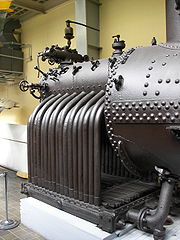
List of boiler types, by manufacturer
Encyclopedia
There have been a vast number of designs of steam boiler, particularly towards the end of the 19th century when the technology was evolving rapidly. A great many of these took the names of their originators or primary manufacturers, rather than a more descriptive name. Some large manufacturers also made boilers of several types. Accordingly it is difficult to identify their technical aspects from merely their name. This list presents these known, notable names and a brief description of their main characteristics.
}:
|}
A
| Definitions | Points of Interest |
|---|---|
|
|
B
| Definitions | Points of Interest |
|---|---|
|
 |
C
| Definitions | Points of Interest |
|---|---|
|
|
D
| Definitions | Points of Interest |
|---|---|
- : A donkey boiler is used to supply non-essential steam to a ship for 'hotel' services such as heating or lighting when the main boilers are not in steam, for example, when in port. Donkey boilers were also used by the last sailing ships for working winches and anchor capstans.
See also auxiliary boiler.
- Du Temple boiler: An early naval water-tube boiler, patented in 1876.
- Dublin "economic" boiler: a vertical multitubular return fire-tube design, for model engineeringModel engineeringModel engineering is the hobby of constructing machines in miniature. The term was in use by 1888. There is some debate about the appropriateness of the term...
-scale uses.
- Dürr boiler An early naval water-tube boiler, developed and mostly used in Germany, but also trialled in the British
|}
E
| Definitions | Points of Interest |
|---|---|
|
|
F
| Definitions | Points of Interest |
|---|---|
|
|
G
| Definitions | Points of Interest |
|---|---|
|
|
H
| Definitions | Points of Interest |
|---|---|
|
|
I
| Definitions | Points of Interest |
|---|---|
|
J
| Definitions | Points of Interest |
|---|---|
|
K
| Definitions | Points of Interest |
|---|---|
|
|
L
| Definitions | Points of Interest |
|---|---|
|
|
M
| Definitions | Points of Interest |
|---|---|
|
|
N
| Definitions | Points of Interest |
|---|---|
|
|
P
| Definitions | Points of Interest |
|---|---|
|
|
R
| Definitions | Points of Interest |
|---|---|
|
|
S
| Definitions | Points of Interest |
|---|---|
|
|
T
| Definitions | Points of Interest |
|---|---|
|
|
V
| Definitions | Points of Interest |
|---|---|
|
|
W
| Definitions | Points of Interest |
|---|---|
|
|
Y
| Definitions | Points of Interest |
|---|---|
|
|

